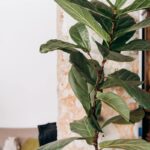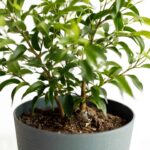As a certified arborist, it is my duty to share my knowledge on the proper pruning techniques for fig trees. Fig trees are a popular fruit-bearing tree that can be found in many gardens and orchards. However, without proper pruning, these trees can become overgrown and produce less fruit. Pruning is an essential task that not only helps keep the tree healthy but also encourages better fruit production.
Pruning should be done during the dormant season when the tree is not actively growing. This period typically falls between late fall and early spring. The main reason for this timing is to avoid causing stress to the tree during its active growth stage because pruning involves cutting off branches and leaves. It’s important to remember that fig trees produce fruit on new growth from the previous year, so pruning should not be too severe or else it may reduce next year’s crop yield. In this article, I will detail the steps involved in correctly pruning fig trees so that they can thrive and produce abundant fruit each year.
The Importance Of Pruning For Fig Trees
Pruning is a crucial aspect of maintaining the health and productivity of fig trees. The benefits of pruning include controlling the size and shape of the tree, promoting healthy growth, and increasing fruit yield. However, it is important to note that improper pruning can damage the tree and reduce its overall health.
To ensure successful pruning, there are several tips to keep in mind. First, timing is key. Pruning should be done during the dormant season when the tree is not actively growing. This typically occurs in late winter or early spring before new growth begins. Second, it is important to use sharp, clean tools to avoid damaging the tree or spreading disease. Third, it is crucial to understand the growth habits of fig trees and prune accordingly.
As certified arborists, we understand that successful pruning requires careful consideration of each individual tree’s needs. By following these tips and understanding the benefits of proper pruning techniques, you can help ensure that your fig trees remain healthy and productive for years to come. In the next section, we will discuss how understanding the growth cycle of fig trees can further aid in successful pruning strategies.
Understanding The Growth Cycle Of Fig Trees
Pruning is an essential task for fig tree growers. It helps maintain the tree’s shape and size, improves fruit quality and quantity, and prevents the spread of diseases. However, before pruning your fig trees, it is crucial to understand their growth cycle.
Understanding fig tree pollination is vital in determining when to prune your trees. Fig trees are unique because they have a unique pollination process called caprification. Caprification relies on a specific type of wasp that enters the fig fruit and transfers pollen from male to female flowers. Therefore, it is best to prune fig trees after harvesting the fruit because this ensures that you do not remove any viable flowers or wasps.
Fig tree growth patterns in different climates also affect when you should prune them. In warmer climates, fig trees may grow all year round, while in colder regions, they may go dormant during winter months. Pruning should be done during the dormant season when there is no active growth, allowing the tree to heal correctly without affecting its productivity. Understanding these growth patterns can help you plan when to prune your fig trees and ensure optimal health and productivity.
Identifying when to prune fig trees is crucial for maintaining healthy plants and high-quality fruit yield. Pruning at the right time allows for better air circulation within the canopy, encourages new growth, and promotes fruit production. In the next section, we will discuss how to identify when it is time to prune your fig trees based on their age and growth patterns.
Identifying When To Prune Fig Trees
As a certified arborist, it is essential to understand when the optimal timing for pruning fig trees is. Pruning at the right time can maximize the health and productivity of your fig tree. The ideal period to prune your fig tree is in late winter or early spring, before new growth begins.
Identifying when your fig tree requires pruning depends on signs of overgrowth. If you notice that your tree has become too bushy or dense, it may be time to prune it. Additionally, if there are dead or diseased branches present, they must be removed as soon as possible. Keep an eye out for crossing branches, which can hinder airflow and lead to disease.
In summary, identifying the optimal timing for pruning and recognizing signs of overgrowth are crucial for the long-term health of your fig tree. In the next section, we will assess the health of your fig tree and identify other factors that could impact its well-being.
Assessing The Health Of Your Fig Tree
Examining Foliage: It is important to inspect the foliage of a fig tree to look for signs of disease, discoloration, or insect damage. Examining Bark: The bark of a fig tree should be inspected for signs of splitting or cracking, which could indicate problems with the root system. Assessing Growth: The overall growth of a fig tree should be observed to ensure that it is healthy and showing signs of healthy growth. Prune: Pruning a fig tree can help to maintain its health and should be done carefully and selectively to avoid potential damage.
Examining Foliage
Observing growth patterns and analyzing foliage are essential steps in assessing the health of your fig tree. As a certified arborist, it is crucial to understand the intricacies of a fig tree’s growth habits to identify any potential issues. Examining foliage can reveal critical information about the overall health of your tree, including nutrient deficiencies or pest infestations.
When examining foliage, look for any discoloration, wilting, or changes in texture. Discoloration can indicate a lack of nutrients or possibly a fungal infection. Wilting may signify root damage or dehydration, while changes in texture could indicate the presence of pests. Analyzing these patterns can help determine the underlying cause and take appropriate action to rectify the issue.
Another important factor to consider when examining foliage is leaf drop. While it is natural for some leaves to fall off during various seasons, excessive leaf drop could be indicative of an underlying problem with your fig tree. Be sure to monitor leaf drop regularly and address any issues promptly to ensure your tree remains healthy and vibrant year-round.
In conclusion, examining foliage is a vital aspect of assessing the health of your fig tree as it provides valuable insights into potential nutrient deficiencies, pest infestations or other issues that may affect its growth and overall well-being. By observing growth patterns and analyzing foliage closely, you’ll be well-equipped to identify any problems early on before they become more severe and impact your tree’s long-term health.
Examining Bark
As a certified arborist, examining bark is another crucial aspect of assessing the health of your fig tree. The bark serves as a protective layer for the trunk and branches, and any signs of disease or damage can indicate potential issues with the tree’s overall well-being. When examining the bark, look for any discoloration, cracks or splits, or areas where the bark has fallen off. These may be signs of disease or pest infestations that require immediate attention. Additionally, analyzing the color and texture of the bark can also help identify the age of the tree.
Discoloration in the bark can signify a fungal infection or pest infestation, which can weaken the tree’s structure and lead to further damage if left untreated. Cracks or splits in the bark may indicate physical damage to the tree from environmental factors like extreme temperatures or improper pruning techniques. By identifying these issues early on through careful examination of the bark, you can take appropriate action to address them promptly.
In conclusion, examining bark is an essential step in assessing the health of your fig tree as it provides valuable insights into potential disease and damage that may affect its growth and well-being. As a certified arborist, it is crucial to understand how to identify these signs and take appropriate action to address them promptly. By combining careful observation of growth patterns, foliage, and bark quality, you’ll be well-equipped to keep your fig tree healthy and vibrant for years to come.
Preparing Your Tools For Pruning
Selecting the right tools for pruning is essential to achieving optimal results. When selecting tools, it is necessary to consider their purpose and quality. Pruning shears are the most commonly used tool for fig tree pruning. It is recommended to use high-quality pruning shears that will provide a clean cut without damaging the plant’s tissue.
Proper tool maintenance is crucial to ensure longevity and performance. After each use, it is necessary to clean and sanitize your tools. Removing any sap, debris, or rust from the blades will prevent disease transmission between plants. Sharpening your tools regularly also ensures that you can make precise cuts with ease.
In addition, it is important to store your tools properly after use. This prevents damage to the blades and handles while also ensuring that they are readily available for future use. Keeping your tools in good condition will save time, money, and effort in the long run while promoting healthy plant growth. With these tips in mind, you are ready to prepare your tools for fig tree pruning and achieve optimal results.
Transitioning into the subsequent section about basic pruning techniques for fig trees: Now that you have prepared your tools adequately, it’s time to learn about basic pruning techniques for fig trees that will promote healthy growth and fruit production.
Basic Pruning Techniques For Fig Trees
- Pruning fig trees is an important part of maintaining their health and vigor.
- Dead or diseased branches should be removed as soon as they are observed in order to prevent their spread to other parts of the tree.
- Training and shaping can be done by pruning lower branches to encourage upward growth and by pruning side branches to create a more desired shape.
- To reduce overgrowth, thinning out dense areas of the inner canopy can be done to allow for increased light and air penetration.
- Proper timing of pruning is important for avoiding damage to the tree and ensuring healthy growth.
- All pruning should be done with sharp tools to ensure clean and precise cuts.
Removing Dead Or Diseased Branches
Assessing damage and removing dead or diseased branches is a crucial aspect of basic pruning techniques for fig trees. As a certified arborist, it is important to assess the extent of the damage and determine if the branch can be saved or if it needs to be removed entirely. Dead branches can be identified by their lack of foliage or growth, while diseased branches often have discolored leaves or unusual growth patterns.
When pruning diseased branches, it is important to sterilize your tools between cuts to prevent spreading the disease. Cut back to healthy wood, making sure not to leave behind any stubs or jagged edges that could attract pests or disease. If the damage is extensive, it may be necessary to remove the entire branch. In these cases, make the cut just outside of the collar where the branch meets the trunk.
Proper pruning techniques for dead or diseased branches not only helps maintain the health and appearance of your fig tree but also promotes new growth and fruit production. Regularly assessing your tree for damage and taking action as needed can prevent further spread of disease or infestation and ensure your tree remains strong and productive for years to come.
Training And Shaping
As a certified arborist, it is essential to know that training and shaping are crucial aspects of basic pruning techniques for fig trees. When planting a fig tree, it is important to consider the location and sunlight requirements as these factors can significantly affect the growth and development of your tree. Proper training and shaping techniques ensure that your tree grows in the desired direction and shape, allowing for easier maintenance and better fruit production.
Training starts with choosing a central leader branch, which will become the main trunk. The lateral branches should be pruned back to encourage strong upward growth, forming a pyramid shape. As the tree grows taller, prune back the top branches to maintain the pyramid shape while allowing sunlight to penetrate through the canopy.
Shaping involves removing any unwanted or crossing branches that may hinder fruit production or cause damage. It also includes removing any suckers that may grow from the base of your tree. Proper shaping techniques keep your fig tree looking neat and well-maintained while promoting healthy growth and maximum fruit production. By following these basic pruning techniques for fig trees, you can ensure that your tree remains healthy, productive, and visually appealing for years to come.
Reducing Overgrowth
As a certified arborist, it is important to understand that reducing overgrowth is another crucial aspect of basic pruning techniques for fig trees. Overgrown branches and foliage can hinder the growth and development of your tree, leading to poor fruit production and potential damage. Proper techniques in reducing overgrowth ensure that your fig tree remains healthy, productive, and visually appealing.
One effective method in reducing overgrowth is thinning out the canopy of your fig tree. This technique involves removing select branches from the interior of the canopy to allow sunlight to penetrate through, promoting better fruit production and healthier growth. Another way is by using heading cuts, which involve cutting back the ends of longer branches to promote lateral growth while maintaining a manageable size.
To effectively reduce overgrowth in fig trees, proper equipment such as sharp pruning shears or loppers must be used. Before making any cuts, it is important to assess each branch’s location and health to avoid damaging healthy parts of the tree. By incorporating these pruning techniques and equipment into your maintenance routine, you can ensure that your fig tree remains healthy and productive for years to come.
Removing Dead Or Damaged Branches
As an arborist, one of the most important tasks in pruning fig trees is removing dead or damaged branches. Dead branches not only ruin the aesthetic appeal of fig trees, but they also pose a potential safety hazard. Similarly, damaged branches can lead to disease and insect infestations that could spread to other parts of the tree. Therefore, it is essential to remove such branches as soon as possible.
To begin with, assess which branches are dead or damaged and need pruning. Using pruning shears, remove dead branches by cutting them back to the nearest healthy branch or main stem. Be sure to make clean cuts at a slight angle, avoiding leaving any jagged edges that could invite pests and disease into the tree.
When assessing damage for pruning purposes, look out for signs such as cracks, splits or tears in bark tissues. Such wounds can be detrimental if left unattended since they provide entry points for pathogens that cause diseases. Additionally, assess whether there are any areas where branches have started to grow too close together, causing rubbing or crossing over one another. Such areas should also be pruned away before they become problematic.
As an arborist who values serving others through my work, I cannot stress enough how important it is to remove dead and damaged branches when pruning fig trees. By doing so regularly and correctly using proper tools like pruning shears, you not only improve the appearance of your tree but also reduce potential hazards while promoting healthy growth. With this in mind, let us now move on to cutting back overgrown branches for optimal growth and fruit production.
Cutting Back Overgrown Branches
- Selective pruning of overgrown fig trees is essential to maintain the health and structure of the tree.
- Pruning should be done with sharp tools to ensure a clean, healthy cut that will help the tree heal quickly.
- The best time for pruning fig trees is late winter or early spring before the growing season begins.
- Fig trees should be pruned each year to ensure healthy growth and reduce the risk of disease or insect infestation.
Selective Pruning
Selective pruning is a technique that can help maintain the health and aesthetics of fig trees. This process involves choosing specific branches to remove, leaving others intact. By selectively pruning, you can direct the tree’s growth to emphasize certain areas while minimizing others. This can be especially useful when dealing with overgrown trees that have become difficult to manage.
To start with selective pruning, it is important to identify which branches to target. A good rule of thumb is to look for branches that are diseased, damaged or dead. Cutting these away will help improve the overall health of the tree and prevent further damage from occurring. Additionally, you may also want to consider removing any branches that are crossing each other or growing in awkward directions. By doing so, you can promote better air circulation and ensure that the remaining branches receive enough sunlight.
One of the benefits of selective pruning is that it allows you to shape your fig tree according to your preferences. By carefully selecting which branches to prune, you can create a more open canopy that lets in more light and air. This can encourage better fruit production as well as reduce the risk of disease and pest infestations. With proper care and attention, selective pruning can help keep your fig tree healthy and productive for years to come.
Proper Timing
As certified arborists, we always prioritize the health and safety of our clients’ trees. Cutting back overgrown branches is a common practice that we do to maintain the structural integrity of the tree and prevent any potential hazards. However, it’s essential to know the proper timing when performing this task to minimize stress on the tree and achieve optimal results.
One of the best practices when cutting back overgrown branches is to do it during the dormant season. In most regions, this occurs during late winter or early spring when there are no leaves on the tree. During this time, pruning wounds heal faster, and the tree’s energy is directed towards new growth in preparation for the upcoming growing season. This timing also makes it easier to see which branches need to be removed since you can identify their structure without any foliage covering them.
One of the common mistakes that people make when cutting back overgrown branches is doing it during active growth periods. This practice can cause significant stress on the tree because it requires more energy to heal from pruning wounds while also producing new growth simultaneously. It can also increase susceptibility to pests and diseases due to open wounds on newly formed branches. By following proper timing practices and avoiding common mistakes in pruning, you can help ensure your fig tree remains healthy and aesthetically pleasing year-round.
Pruning Young Fig Trees
When it comes to pruning young fig trees, there are several key considerations to keep in mind. First and foremost is the pruning frequency, which will depend on the age of the tree and its growth rate. In general, young fig trees should be pruned annually for the first few years of their life in order to promote strong branching and healthy growth.
When it comes to pruning techniques, there are a few different approaches that can be taken depending on the desired outcome. One common technique is known as “heading back,” which involves cutting back the tips of branches by one-third to one-half in order to encourage more lateral growth. Another approach is called “thinning out,” which involves removing whole branches or stems from the tree in order to improve air circulation and allow more light to reach the remaining branches.
Overall, proper pruning is essential for maintaining healthy young fig trees and ensuring they grow into strong, productive plants. By understanding the right pruning frequency and techniques for your specific tree, you can help ensure its long-term success and productivity.
Moving forward, it’s important to note that as your fig tree matures, its pruning needs will change accordingly. In our next section, we’ll explore some of the key considerations when it comes to pruning mature fig trees for optimal health and productivity.
Pruning Mature Fig Trees
How do you properly prune a mature fig tree? As a certified arborist, I know that this is a common question for gardeners and those who want to keep their trees healthy and productive. Pruning can help increase fruit production, maintain the shape of the tree, and prevent disease. But before we talk about types of cuts and timing, it’s important to understand why pruning is crucial for fig trees.
Mature fig trees require pruning every year to remove dead or diseased wood, promote new growth, and keep the tree manageable in size. Pruning can also increase sunlight penetration into the canopy, which can lead to better fruit quality. When making cuts on your fig tree, it’s important to use clean and sharp tools to prevent damage or infection. Types of cuts include thinning out branches, heading back lateral shoots, removing suckers from the base of the tree and cutting off deadwood.
Timing of cuts is also essential when pruning your mature fig tree. Typically, pruning should be done in late winter or early spring before new growth begins. This will encourage new growth during the growing season. However, if you notice any damaged or diseased wood throughout the year, it’s best to remove it as soon as possible to prevent further damage. With these tips in mind, you’ll be able to properly prune your mature fig tree and keep it healthy for years to come.
Now that you’ve learned about proper pruning techniques for your mature fig tree let’s discuss how to train your fig tree to a desired shape.
Training Your Fig Tree To A Desired Shape
As a certified arborist, I understand the importance of shaping a fig tree to promote healthy growth and fruit production. Training techniques are essential for creating the desired shape and size for your tree, as well as preventing potential hazards such as broken branches or weak limbs. One shaping strategy is to prune your fig tree during the dormant season, which typically occurs in late winter or early spring.
Before pruning, assess the overall shape of your fig tree and identify any problem areas that may need attention. Begin by removing any dead or damaged branches, followed by any crossing or rubbing branches. To create an open center shape, remove any interior branches that are growing towards the center of the tree. If you prefer a single trunk form, select one main trunk and remove any competing shoots.
Another training technique is to use stakes or trellises to support the growth of your fig tree. This method can help prevent heavy fruiting branches from breaking under their own weight and encourage upward growth rather than outward. When using stakes or trellises, be sure to tie the branches gently with soft materials such as twine or fabric strips to avoid damaging the bark. With proper training techniques and shaping strategies, you can create a beautiful and healthy fig tree that produces abundant fruit.
Transition: While proper training techniques can help prevent issues with your fig tree’s growth and shape, pests and diseases can still pose a threat. It’s important to know how to deal with these problems effectively to ensure the continued health of your tree.
Dealing With Pests And Diseases
Preventative measures are always the best way to keep your fig tree healthy. Proper pruning is one such measure that can help prevent disease and pest infestations. By removing dead or diseased branches, you can prevent the spread of harmful pathogens throughout the tree. Additionally, pruning helps improve airflow and sunlight penetration within the canopy, creating an environment that is less conducive to pest activity.
Eco-friendly solutions should also be considered when dealing with pests and diseases on your fig tree. Chemical treatments may be effective, but they can also harm beneficial insects and other wildlife in your garden. Instead, try using natural products such as neem oil, which has been shown to effectively control common fig tree pests like spider mites and whiteflies. Companion planting is another eco-friendly solution that can help deter pests naturally. Herbs like basil and mint planted near your fig tree can repel aphids and other small insects.
By taking preventative measures and using eco-friendly solutions when necessary, you can maintain a healthy fig tree without harming the environment around it. However, if pest or disease problems persist despite these efforts, it may be necessary to seek professional advice from a certified arborist who can provide additional guidance on treatment options.
Transition: Now that you know how to deal with pests and diseases on your fig tree, it’s important to also understand how to care for it after pruning.
Caring For Your Fig Tree After Pruning
Dealing with pests and diseases is an essential aspect of caring for your fig tree. However, pruning is also a vital practice that promotes the health and growth of your tree. After you prune your fig tree, you need to take proper care of it to ensure it grows strong and healthy.
Caring for your fig tree roots is crucial for its overall health. You should ensure that the soil around the tree’s roots remains moist but not waterlogged. Overwatering can lead to root rot, while under-watering can cause the roots to dry out, leading to stunted growth or death. Additionally, you should avoid planting other trees or shrubs near your fig tree as they may compete with it for water and nutrients.
Fertilizing after pruning is another crucial aspect of caring for your fig tree. When pruning, you remove some of the nutrients that would have been used by the plant for growth and development. Therefore, adding fertilizer replenishes these nutrients and supports healthy growth in the following season. Apply a balanced fertilizer at least once or twice per year during early spring or late winter when the plant is dormant.
- Watering: Ensure proper watering practices to avoid over- or under-watering
- Soil testing: Test soil pH levels regularly to maintain optimal conditions
- Mulching: Use organic mulch such as leaves or straw to help retain moisture and regulate soil temperature
- Pruning frequency: Prune only when necessary as excessive pruning can harm the plant.
- Pest control measures: Take preventive measures against pests that may attack your fig trees.
As arborists, our goal is to provide guidance on caring for trees while minimizing potential harm caused by human intervention. Proper pruning techniques combined with adequate care practices are essential in promoting healthy growth in fig trees. By following these guidelines, you will not only optimize yield but also prolong your tree’s lifespan.
Moving forward, it’s essential to be aware of common mistakes to avoid when pruning fig trees.
Common Mistakes To Avoid When Pruning Fig Trees
Pruning a fig tree can be daunting for the uninitiated. But with proper knowledge of the techniques and timing, pruning can be an essential part of maintaining a healthy fig tree that produces an abundance of fruit. As important as knowing how to prune is understanding what not to do. Common mistakes to avoid when pruning fig trees include improper timing and excessive cutting.
Improper timing is one of the most common mistakes made when pruning fig trees. It’s crucial to prune at the right time because it affects the tree’s growth and fruit production. Pruning during dormancy or in winter can damage your tree, leading to reduced fruit production or even death. On the other hand, waiting too long before pruning can lead to overgrowth, which makes it harder to manage your tree later on. The best time for pruning is during late winter or early spring before new growth begins.
Another mistake that many people make when pruning their fig trees is excessive cutting. Over-pruning can lead to various problems such as reduced fruit production, stunted growth, and increased vulnerability to pests and diseases. To avoid this problem, it’s important not to cut more than one-third of your tree at any given time. A good approach is to start with light trimming, then gradually increase as necessary while monitoring your tree’s response.
| Dos | Don’ts |
|---|---|
| Cut diseased branches | Over-prune |
| Prune in late winter/early spring | Prune during dormancy/winter |
| Use sharp tools | Leave stubs behind |
| Thin out overcrowded branches | Cut more than one-third at a time |
By avoiding these common mistakes, you’ll ensure that your fig tree thrives and produces abundant fruits year after year. With patience and practice, you’ll soon become an expert at pruning your fig tree like a pro! In the next section, we’ll discuss how you can maximize fruit production from your pruned fig tree.
Enjoying The Fruits Of Your Labor: Maximizing Fruit Production From Your Pruned Fig Tree
After successfully pruning your fig tree, the next step is to ensure that it produces the highest yield possible. Maximizing yield requires proper care and maintenance throughout the growing season. One of the essential practices for maximizing fruit production is regular watering. Figs require consistent watering, especially during dry spells, to keep the soil moist and promote healthy growth.
Another crucial factor in maximizing yield is fertilization. Fig trees benefit from regular fertilizing with a balanced fertilizer that contains nitrogen, phosphorus, and potassium. The ideal time for fertilization is in early spring when the tree starts producing new growth. Proper fertilization not only increases fruit production but also preserves tree health by promoting strong root development and disease resistance.
Finally, harvesting your figs at the right time is crucial for maximizing yield and preserving tree health. Mature figs should be harvested when they are fully ripe but still firm to touch. Over-ripe figs are more prone to insect infestation and can attract unwanted wildlife such as birds or rodents. Regular harvesting also encourages continued fruit production throughout the growing season.
In summary, maintaining a consistent watering schedule, proper fertilization, and timely harvesting are essential practices for maximizing yield while preserving your fig tree’s health. By following these simple steps, you can enjoy a bountiful harvest of delicious figs year after year.
Conclusion
Pruning is an essential aspect of maintaining the health and productivity of a fig tree. As a certified arborist, it is crucial to understand the growth cycle of fig trees, identify when to prune, assess the health of the tree, prepare tools for pruning, and take measures to prevent pests and diseases. Careful pruning can enhance fruit production while ensuring that your fig tree remains healthy and vibrant.
According to recent statistics, proper pruning can significantly increase the yield of fig trees. In fact, studies have shown that well-pruned trees produce up to 25% more fruit than those left unpruned. However, it is important to avoid common mistakes such as over-pruning or cutting too close to the trunk. These errors can lead to extensive damage or even death of your fig tree.
In conclusion, as a certified arborist, it is essential to understand how to properly prune fig trees. Pruning at the right time and in the right way can promote healthy growth and increase fruit production. By avoiding common mistakes and properly caring for your tree after pruning, you can enjoy bountiful harvests from your fig tree for years to come. Remember that with proper care and attention, your fig tree will continue to thrive for generations.
Image Credits
- “Moreton Bay Fig Tree” by ~Prescott (featured)





























